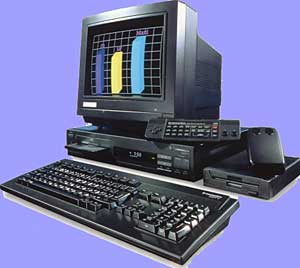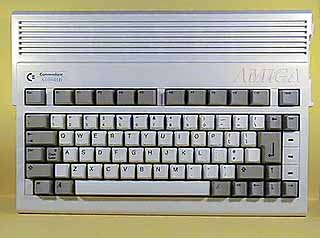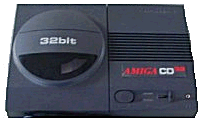 Amiga
in the 90es: another Amiga 500, this time disguised as video recorder: the Commodore
Cd-Tv. In fact it has a 1x CD unit, and a surely nice black. Don't you like it?
Amiga
in the 90es: another Amiga 500, this time disguised as video recorder: the Commodore
Cd-Tv. In fact it has a 1x CD unit, and a surely nice black. Don't you like it?2. THE STORY
Amiga story sounds as unreal. In the first 80es three doctors invest much money
to make computers. Some people with a good know-how (as Jay Miner, ex Atari)
work for it. In the beginning it was Hi-Toro, an innocuous company that manufactured joystick. Then
"Amiga" name is chosen, it means "friendly". In origin the idea was that one to plan a machine
for game, constructed on the powerful processor used in arcade machines, the Motorola 68000 (and the choice of this
processor made easier games porting. Someone disagrees, and wants to build a
computer. The solution? Implementing typical members of I/O of the computers
"hiding them". This made easy to convert the project in a real
computer after 1983 games crisis.
Amiga gets out of money, Jay Miner and friends must look for a big company. The Atari offers a misery, the Commodore not, and obtains the plans, the licences and the Atari hate. So inT1985 Amiga 1000, 256 KB of RAM, 4096 colors, real multitasking comes out, with Microsoft and Macintosh that have monochromatic monitors: 4095 colors of difference... But Amiga 1000 suffer the competition of Atari, and Commodore must work hard, in USA and Germany, to show to the world, in 1987, one of the best friendly computer ever realised for quality and technology (related to 1987, of course...): the Amiga 500. It comes applauded as the definitive computer, and wins a prize as best eletronic product of 1987. Commodore Amiga starts to sell also a more professional computer, the Amiga 2000, even if people thinks that only IBM PCs are professional, because they see them where they work.
 Amiga
in the 90es: another Amiga 500, this time disguised as video recorder: the Commodore
Cd-Tv. In fact it has a 1x CD unit, and a surely nice black. Don't you like it?
Amiga
in the 90es: another Amiga 500, this time disguised as video recorder: the Commodore
Cd-Tv. In fact it has a 1x CD unit, and a surely nice black. Don't you like it?
 After
this, a new chipset for Amiga, ECS. Too many model comes out even every 6 months,
500 plus (enough 500!), 600 (in the photo, a computer without numeric pad).
After
this, a new chipset for Amiga, ECS. Too many model comes out even every 6 months,
500 plus (enough 500!), 600 (in the photo, a computer without numeric pad).
 Perhaps the most important innovation
of Amiga is AGA chipset: with it and the programs Lightwave and Toaster the Amiga enters with overbearingness in the world of the graphical computer for film, television film and videoclip. In those
years, Commodore knows another fail with Amiga CD 32, a 32 bit consolle with AGA
chipset.
Perhaps the most important innovation
of Amiga is AGA chipset: with it and the programs Lightwave and Toaster the Amiga enters with overbearingness in the world of the graphical computer for film, television film and videoclip. In those
years, Commodore knows another fail with Amiga CD 32, a 32 bit consolle with AGA
chipset.
1994: the Commodore accumulates heavy debts to you, doesn't commercialize the new
chipset and goes out of business. I must say that it was not easy to do it, but
Commodore ideas of marketing were perfect to kill itself. Sad days for the
programmers, remembered in "Deatbed Vigil". The race to save the Amiga before that it sinks with to the
ship begins. Escom from Germany seems able. Amiga users say "it's done".
In fact, also Escom goes out of business, failing to commercialize a new Amiga, called
Walker. The future seem to be with Viscorp, but in 1997 Gateway a true colossus made in
USA buys Amiga. But the wedding between Amiga and Gateway remains without sons (except
a prototype X-Box like, but Gateway did not have some interest to put it in production).
In the beginning of 2000, the Amiga brand passes in the hands of Bill McEwen.
And now? Amiga users wait for new hardware, they had to be pleased for years
with some Power PC cards made by Phase5 that however carried the Amiga until today
(and Phase5 to death). AmigaOne and Pegasos are the hope for the future. Amiga
users love his plactform without compromise, and they survived even without a
company above them. For them, it's better this than "temptations of comfort"
by Microsoft.